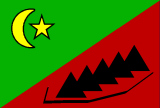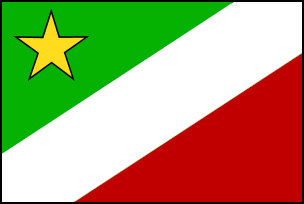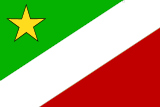Repubblika tal' Naquarnia
Fact Sheet:
- Size: 95'000 q
- Religion: 49% Muslim, 24% Cathulic, 3% Jewish, 19% no religion, 5% other
- Language: Eetalijan, Murwillanian, English
- Capital: Arnaq (originally called Biquaia)
- Official Names: Repubblika tal' Naquarnia / Jumhuriat Naquarnia / Republic of Naquarnia
- Short Names: Naquarnia / Repubblika Naquarnia
The historical roots of Naquarnia lie in a number of coastal trade-oriented towns with Arabic cultural influences, surrounded by poor mountaineous rural areas influenced by the Eetalijan culture. For a long time, there was no real central control, only an assembly of representatives of the different regions in Arnaq, the centrally located traditional assembly town, electing four "Duqes" as representants of the Naquarnian Alliance. Naquarnia joined the former Musogradian Empire on 1965.10.03, when the Treaty of Alte Ceccato was signed, but always maintained a level of autonomy within the Musogradian state and later the Federation.
The northern part of Naquarnia is covered by the Ghibalni mountains; in the south, Naquarnia covers about 40% of the Djisr peninsula, bordering the former Sultanate of Djisara. The Republic is one of the poorest regions of the Federation, with limited agriculture due to lack of water and arable land. It has accepted a high number of Eetalijan refugees who left the Territorio Sovrano di Mondeo during the occupation and after its final abolition.
This migration has strengthened the rural Eetalijan culture in Naquarnia and led to a renaissance of the Eetalijan language in Naquarnia, pushing Murwillanian (itself a hybrid of Arabic and Eetalijan) and English somewhat into the background.
Old flag of the Republic of Naquarnia (until 2020):

After a Coup d'Etat on 2010-07-23, a Provisional Government was set up. On 2011-02-21, it was replaced by an Interim Government of neutral professionals, led by a veterinarian. Democratic elections of a new Parliament and Government were carried out in May 2011, resulting in a coalition government of liberal Islamic parties and the Trader Alliance.
In 2013, the Light! Movement gained a foothold, supported by the youth, but in contrast to the Shiat al Nur movement in the Jamahiriya Murwillumbah, it remained peaceful, demonstrating for education and against religion. In 2015, the Knowledge and Discipline Party (KDP), the strongest Islamic party, has formed a coalition with Light! and the Trader Alliance to guarantee stability.
In 2019, the traditional parties lost many votes, and a new coalition was formed, led by Alljanza Chadra / Alleanza Verde, a multicultural ecologic movement, supported by Light! and the Trader Alliance.
The Republic of Naquarnia has refrained from sending forces to support Operation Shoolscath, but is allowing the usage of its ports and air bases by FM forces involved in the operation.
On 2020-10-03, the 55th anniversary of the Treaty of Alte Ceccato, the official state name was changed to the Eetalijan version "Repubblika tal' Naquarnia", and the flag was changed, removing a religious element in the upper and the symbolic mountain range in the lower part of the flag, and inserting a white diagonal stripe instead, symbolizing openness, hope and the peaceful aspirations of the nation.

| 

